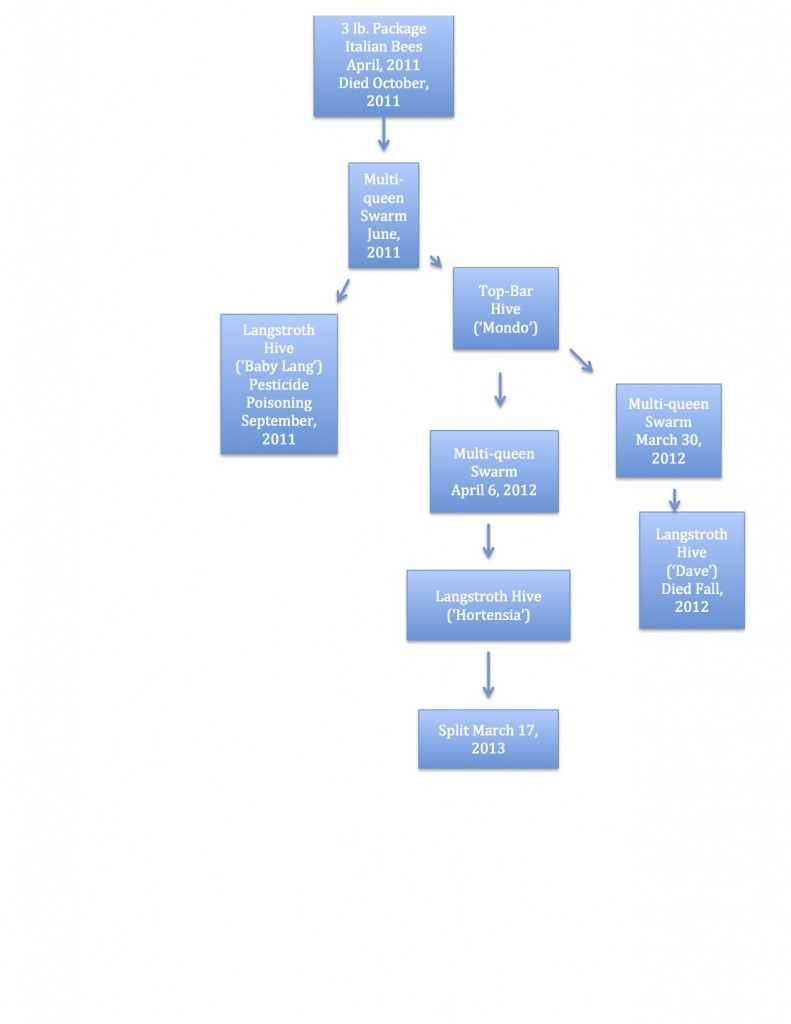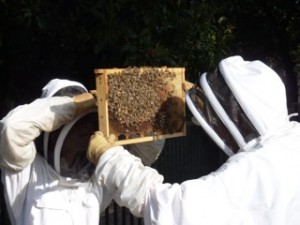It’s that time of year again! Two out of three of the hives we inspected this past weekend had queen cells in some stage of development. After months of book learning, discussion with beekeeping friends, and formation of a new subgroup in our bee guild dedicated to gaining and disseminating knowledge of how to divide hives and raise queens locally (‘The Bee Selective’), Kelly and I finally made our first hive split.
We were fortunate to have Nickie, a beekeeping buddy, along who helped us muddle through (real life always varies from what you read in books). Following are the hive stats and details on how we made the split. Long live the queens!
What we started with: onsite equipment
–Ten-frame Langstroth (all deeps) with seven frames per box and follower boards, a la Serge Labesque, three boxes total.
Hive lineage
–Spring 2011 bee package purchased from Olivarez Honey Bees, originally hived in Redwood City, CA.
–Swarmed in June 2011 with multiple queens, and we hived two groups of bees (one in a Lang, one in a top-bar).
–The top-bar (still in Redwood City) lived through the winter and swarmed at least three times in March and April 2012. Again, all were multiple queen swarms (6-10+ queens per swarm).
–The bees we just split overwintered in San Mateo from one of those swarms. They were a small group last year, and we harvested no honey.
Is that a queen in your pocket?
We began in the morning and soon discovered several closed queen cells at the bottoms of frames in the top (third) box. We also saw lots of drone brood, and some capped worker brood. We returned in the late afternoon with extra equipment to split the hive and proceeded to do a more in-depth inspection. We wanted to be sure that the queen cells were swarm cells, not supersedure cells to create an emergency replacement queen.
Though we never found the queen, we did find lots of eggs on one of the frames in the third box, as well as larvae, suggesting that a healthy queen has been laying since the worker bees made the queen cells. However, the frames predominantly held capped worker and drone brood (consistent with a hive that is preparing to swarm). We found many more queen cells, some of which were built between boxes and ripped open when we lifted boxes off to inspect below. We also were somewhat surprised to find brood in all three boxes. We would have expected the queen to be hanging out in the upper portion of the hive at this time of year. Clearly, the hive was congested.
Splitting the hive
We assembled a bottom board and one deep eight-frame box and selected four frames from the established hive. Two frames had queen cells and capped worker brood. The other two were predominantly honey (capped and uncapped) and pollen. All the frames were covered in bees, and we also shook bees from two other frames on top of the open box. We slapped on an inner cover and telescoping cover, and added an entrance reducer to the front of the hive so that this small group of bees has a smaller front door to guard.
Finally, we consolidated the brood and added replacement frames to the outer edges of the boxes. We also added an eighth frame to each box (because the bees had seemed cramped and an eighth frame fits easily with the follower boards in ten-frame equipment). We also added an extra deep box on top, bringing the total to four boxes.
We think we split too late to prevent swarming, but we decided to go forward with splitting the hive because of the longevity, honey production, and mellow nature of this lineage in our apiary. These bees aren’t taking any chances with queen rearing; Kelly thinks she counted 20-25 queen cells, though I would place the number somewhat lower.
We will keep you posted! In the meantime, enjoy the photos our beekeeping friend Nickie Irvine took.





5 Responses to Spring Hive Split